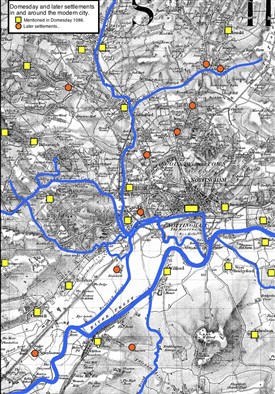A city greater than the sum of its part

Domesday and later settlements in and around Nottingham.
©RHoward
Celebrating Nottingham's domesday communities
By Robert Howard
I believe Nottingham has been made a great city by a series of historic marriages of mutual self-interest. My map shows the fourteen Domesday settlements which existed in 1086 within the present-day boundary of Nottingham City Council and what is, in effect, Greater Nottingham. Some have disappeared (Morton and Sutton Passeys for example, with the latter re-emerging as a housing estate in the 20th century).
The coalescence of Nottingham and its neighbouring domesday settlements into a city greater than the sum of its parts is, I believe, a largely untold story. Before they joined with Nottingham, these places had their own identity and achievements to be proud of: Basford was a hosiery centre, Bulwell's grammar school was founded in the 17th century, Lenton's priory gained Nottingham many advantages, later Lenton had hats and lace, Radford had a pleasure garden and Wollaton a grand house and coal. Then there was the River Leen, as important as the Trent in its own way. I am sure many reading this can add their own examples.
With the coming of the canals, enclosure and the railways, the men of business and industry in the surrounding settlements wanted their share of the action and power, as much as those constrained by tight boundaries wanted the opportunity to expand. Of course, my theory may be wrong, but my heart tells me I am right. I suspect it will take other heads, better than mine, to prove the argument one way or the other.